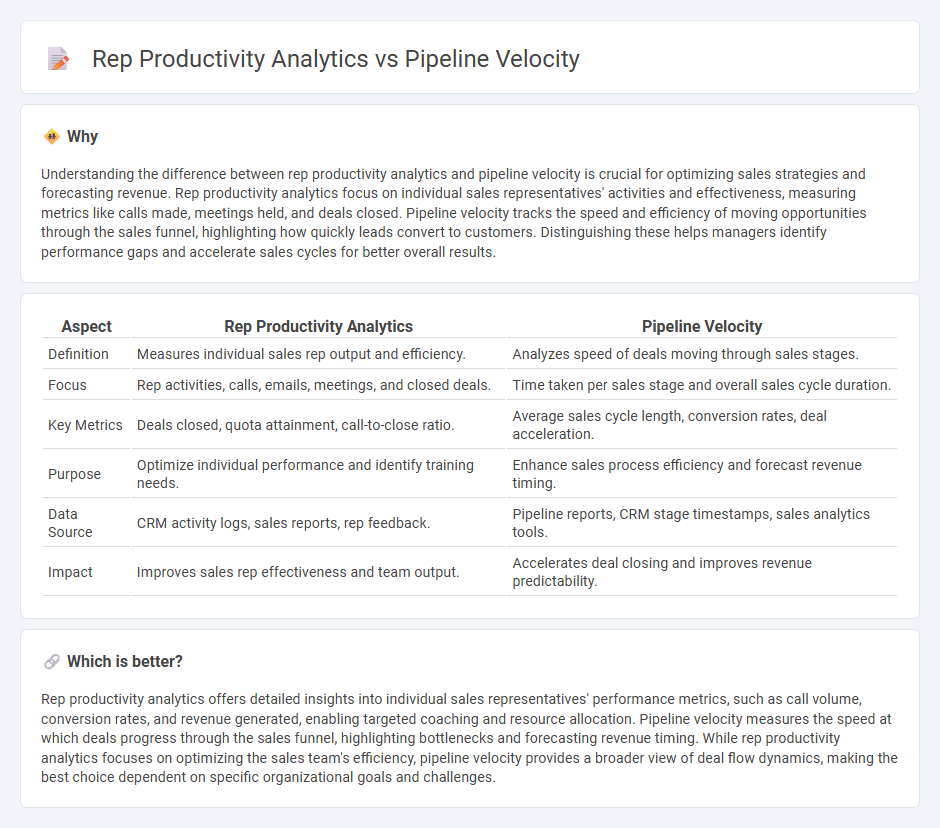
Sales rep productivity analytics measures individual performance using metrics such as call volume, deal closure rate, and revenue generated, providing insights into strengths and areas for improvement. Pipeline velocity tracks the speed at which prospects move through the sales funnel, highlighting bottlenecks and forecasting revenue potential based on deal size, win rate, and sales cycle length. Discover how combining these analytics can enhance overall sales effectiveness and drive revenue growth.
Why it is important
Understanding the difference between rep productivity analytics and pipeline velocity is crucial for optimizing sales strategies and forecasting revenue. Rep productivity analytics focus on individual sales representatives' activities and effectiveness, measuring metrics like calls made, meetings held, and deals closed. Pipeline velocity tracks the speed and efficiency of moving opportunities through the sales funnel, highlighting how quickly leads convert to customers. Distinguishing these helps managers identify performance gaps and accelerate sales cycles for better overall results.
Comparison Table
| Aspect | Rep Productivity Analytics | Pipeline Velocity |
|---|---|---|
| Definition | Measures individual sales rep output and efficiency. | Analyzes speed of deals moving through sales stages. |
| Focus | Rep activities, calls, emails, meetings, and closed deals. | Time taken per sales stage and overall sales cycle duration. |
| Key Metrics | Deals closed, quota attainment, call-to-close ratio. | Average sales cycle length, conversion rates, deal acceleration. |
| Purpose | Optimize individual performance and identify training needs. | Enhance sales process efficiency and forecast revenue timing. |
| Data Source | CRM activity logs, sales reports, rep feedback. | Pipeline reports, CRM stage timestamps, sales analytics tools. |
| Impact | Improves sales rep effectiveness and team output. | Accelerates deal closing and improves revenue predictability. |
Which is better?
Rep productivity analytics offers detailed insights into individual sales representatives' performance metrics, such as call volume, conversion rates, and revenue generated, enabling targeted coaching and resource allocation. Pipeline velocity measures the speed at which deals progress through the sales funnel, highlighting bottlenecks and forecasting revenue timing. While rep productivity analytics focuses on optimizing the sales team's efficiency, pipeline velocity provides a broader view of deal flow dynamics, making the best choice dependent on specific organizational goals and challenges.
Connection
Sales representative productivity analytics measure individual and team performance by tracking key metrics such as call volume, conversion rates, and deal closures. Pipeline velocity quantifies the speed at which deals progress through sales stages, directly impacting revenue generation timelines. Integrating rep productivity data with pipeline velocity insights helps identify bottlenecks, optimize resource allocation, and accelerate sales cycles for improved overall performance.
Key Terms
Lead Conversion Rate
Pipeline velocity measures the speed at which leads move through the sales funnel, directly impacting lead conversion rate by identifying bottlenecks in the sales process. Rep productivity analytics evaluate the efficiency and effectiveness of individual sales representatives, correlating their activities to higher lead conversion outcomes. Explore detailed strategies to enhance pipeline velocity and rep productivity for superior lead conversion rates.
Sales Cycle Length
Pipeline velocity analytics measures the speed at which deals progress through each sales stage, directly impacting the overall sales cycle length by identifying bottlenecks and accelerating opportunity closure. Rep productivity analytics evaluates individual sales representatives' effectiveness based on metrics such as deal conversion rates and activities per stage, influencing how quickly sales cycles can be completed. Discover how optimizing both pipeline velocity and rep productivity can shorten your sales cycle and boost revenue growth.
Revenue per Rep
Pipeline velocity measures the speed at which potential deals move through the sales funnel, directly impacting Revenue per Rep by identifying bottlenecks and accelerating deal closures. Rep productivity analytics evaluate individual sales performance through key metrics like call activity, conversion rates, and deal size to optimize revenue generation per salesperson. Explore how integrating pipeline velocity with rep productivity analytics can maximize your team's Revenue per Rep and boost overall sales efficiency.
Source and External Links
Pipeline Velocity: Definition, Formula & Strategies - Pipeline velocity measures how quickly qualified opportunities move through the sales pipeline, calculated as (Opportunities x average deal size x win rate) / length of sales cycle, helping evaluate the efficiency of the sales process and identify improvement areas.
Pipeline Velocity: SaaS KPIs Explained - Pipeline velocity is a key SaaS KPI measuring the speed and efficiency of converting pipeline opportunities into revenue, reflecting sales health by combining four metrics: number of opportunities, average deal size, win rate, and sales cycle length.
How to Increase Pipeline Velocity for Your Business - Pipeline velocity for B2B sales can be calculated using the formula (Opportunities x average deal size x win rate) / sales cycle length, and improving it involves strategies such as sourcing more intent data to accelerate sales velocity.
 dowidth.com
dowidth.com